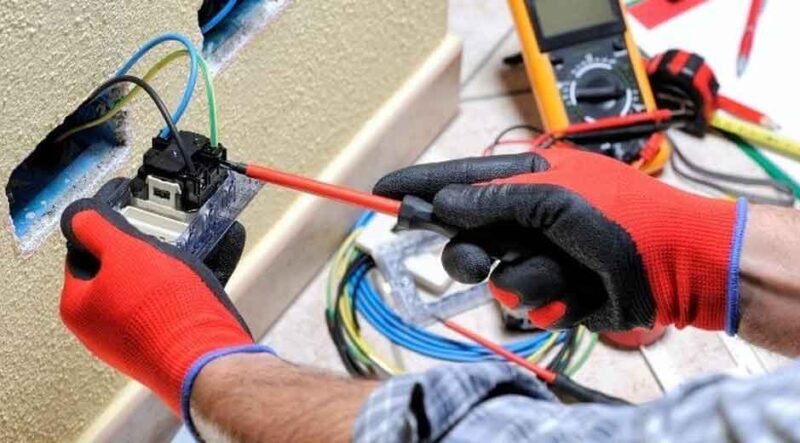Electricity powers nearly every aspect of modern life, from lighting and appliances to communication and industrial machinery. However, when faults occur within an electrical system, it can disrupt daily routines and even create hazardous conditions. Diagnosing and tracing these faults requires a careful and systematic process that ensures safety while restoring functionality. We will explore how electricians approach the task of identifying electrical issues, the methods they use to pinpoint problems, and the logical steps that help restore systems back to proper working order. Understanding this process provides clarity on why accurate fault detection is critical for safety, efficiency, and long-term reliability.
Methods Used to Diagnose and Trace Faults
- Initial Observation and Communication with the Client
The first step in diagnosing an electrical fault often begins with observation and communication. An electrician in Montgomery gathers as much information as possible about the problem by asking the client questions. For instance, they may ask when the issue began, whether it is constant or intermittent, and if it affects specific devices or the entire system. This step is crucial because it provides context that narrows down the potential fault areas.
Observation also involves noticing any visible signs such as flickering lights, unusual sounds, or burning odors from equipment. Combining what the client reports with what is physically observable helps electricians form a preliminary idea of where the fault might be. Instead of blindly testing every component, they use this initial information to create a more targeted diagnostic plan. This step lays the foundation for efficient fault tracing and minimizes unnecessary trial and error.
- Safety Precautions Before Testing
Safety is always prioritized before any testing or fault-finding begins. Electrical faults can present serious risks, including shocks, fires, or equipment damage. Electricians first ensure that circuits are de-energized when necessary by switching off power at the breaker panel or isolating the faulty section of the system. They also use protective equipment such as insulated gloves, voltage-rated tools, and safety glasses to reduce hazards.
Once the environment is deemed safe, they may perform preliminary tests with voltage detectors or continuity testers to confirm that it is safe to proceed further. This stage is not only about protecting the electrician but also about preventing further damage to the electrical system. By implementing strict safety procedures before engaging in diagnostic work, they can focus on identifying faults without risking harm. This cautious approach makes the tracing process both effective and responsible, especially in residential and industrial settings.
- Systematic Testing with Diagnostic Tools
After ensuring safety, electricians move on to systematic testing using a range of diagnostic tools. Multimeters, insulation testers, and clamp meters are common instruments used to measure voltage, resistance, and current flow. For instance, if a circuit breaker is frequently tripping, electricians can test whether it is due to an overload, a short circuit, or a ground fault. They methodically check each component of the circuit, comparing readings against normal expected values.
This step often involves testing from the power source outward, such as from the breaker panel to individual outlets or devices. Diagnostic tools provide precise measurements that help confirm whether a wire, breaker, or appliance is functioning correctly. Without this systematic use of instruments, identifying the exact location of a fault would be largely a matter of guesswork. By combining data from tools with logical reasoning, electricians can trace even the most elusive faults with accuracy.
- Isolation of Faulty Sections
Once testing provides a clearer picture, electricians narrow down the fault by isolating sections of the electrical system. This process involves breaking down the system into smaller segments and testing each one independently. For example, if a lighting circuit is not functioning, they might disconnect specific sections to see where the problem lies—whether it is within the switch, the wiring, or the fixture itself. Isolation prevents unnecessary disruption of the entire system while focusing attention on the exact fault area.
This methodical breakdown is especially useful for complex wiring setups found in commercial or industrial buildings, where multiple circuits are interconnected. By systematically isolating areas, electricians can save time, avoid replacing functional parts, and directly target the component that requires repair or replacement. This precise method of elimination ensures accurate fault detection and reduces downtime for the client.
- Identifying Common Types of Faults
As the fault-tracing process progresses, electricians often encounter patterns that point to common issues. Typical electrical faults include open circuits, short circuits, ground faults, and insulation breakdown. For example, an open circuit might occur due to a disconnected wire, while a short circuit might be caused by two conductors making unintended contact. Ground faults often occur when current leaks to the ground through damaged insulation, triggering safety devices such as ground-fault circuit interrupters.
Recognizing these common fault types helps electricians diagnose problems more quickly, as they can match symptoms to known issues. For instance, if an appliance repeatedly causes a breaker to trip, it is often due to a short or overload condition. By identifying these categories of faults, electricians can apply specific solutions such as replacing wires, tightening connections, or repairing insulation. This structured knowledge enables them to resolve problems effectively while maintaining safety standards.
Faults in electrical systems can be disruptive and hazardous, but diagnosing and tracing them is a structured process that prioritizes safety and accuracy. Each step, from communication with the client to documentation after repair, plays a role in ensuring that faults are resolved thoroughly and future problems are minimized. This combination of logical reasoning, hands-on testing, and preventive thinking ensures electrical systems remain reliable and safe. By understanding how faults are traced, we gain a deeper appreciation of the precision and care involved in restoring power and preventing risks in homes and workplaces alike.









